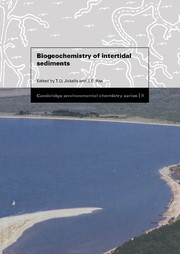Book contents
- Frontmatter
- Contents
- List of contributors
- Preface
- 1 Biogeochemistry of intertidal sediments
- 2 Trace metals in deposited intertidal sediments
- 3 Modelling adsorption and desorption processes in estuaries
- 4 A critical appraisal of the methodology used in studies of material flux between saltmarshes and coastal waters
- 5 Nutrient recycling in intertidal sediments
- 6 An overview of carbon and sulphur cycling in marine sediments
- 7 Microbial activity and diagenesis in saltmarsh sediments, North Norfolk, England
- 8 The behaviour of radionuclides in the coastal and estuarine environments of the Irish Sea
- 9 The sorption of hydrophobic pyrethroid insecticides to estuarine particles: a compilation of recent research
- Index
8 - The behaviour of radionuclides in the coastal and estuarine environments of the Irish Sea
Published online by Cambridge University Press: 23 September 2009
- Frontmatter
- Contents
- List of contributors
- Preface
- 1 Biogeochemistry of intertidal sediments
- 2 Trace metals in deposited intertidal sediments
- 3 Modelling adsorption and desorption processes in estuaries
- 4 A critical appraisal of the methodology used in studies of material flux between saltmarshes and coastal waters
- 5 Nutrient recycling in intertidal sediments
- 6 An overview of carbon and sulphur cycling in marine sediments
- 7 Microbial activity and diagenesis in saltmarsh sediments, North Norfolk, England
- 8 The behaviour of radionuclides in the coastal and estuarine environments of the Irish Sea
- 9 The sorption of hydrophobic pyrethroid insecticides to estuarine particles: a compilation of recent research
- Index
Summary
Introduction
The focus of this chapter is on the behaviour of radionuclides in the coastal and intertidal sediments of the Irish Sea, in particular those in the north-east. A review of previous research concerned with the fate of radionuclides in and around the Irish Sea is presented along with some recent research the authors have performed.
Boundaries of the Irish Sea
The Irish Sea is a semi-enclosed body of water, bounded by the eastern coast of Ireland and the coasts of north Wales, north-west England and south-west Scotland. It connects with the Atlantic Ocean through St George's Channel in the south and the North Channel to the north. Water enters the Irish Sea both through St George's Channel and the North Channel, although the former dominates, and leaves via the North Channel (Howorth, 1984; Dickson, 1987). The flowrate of water out through the North Channel is about 5 × 109m3d-1 and the residence time of the water in the northern Irish Sea is about one year (Pentreath et al., 1984).
In relation to radionuclide behaviour, the distribution of bed sediments according to grain size is of particular importance. Figure 8.1 shows the disposition of bed sediments according to the grain size description of Pantin (1977, 1978). The two main areas of muddy sediments, one extending southwards from St Bees Head, Cumbria, towards Morecambe Bay and the other lying between the Isle of Man and the north-east coast of Ireland, are of particular significance.
- Type
- Chapter
- Information
- Biogeochemistry of Intertidal Sediments , pp. 152 - 172Publisher: Cambridge University PressPrint publication year: 1997



